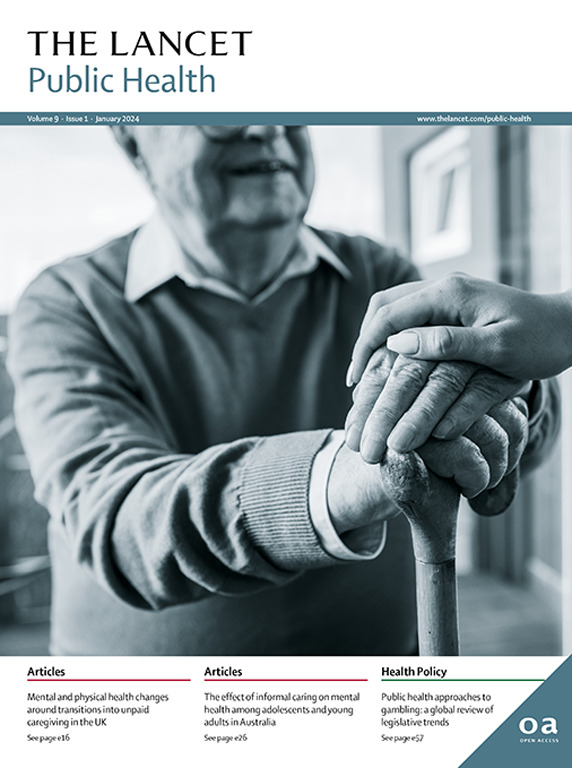Health conditions among women in prisons: a systematic review
IF 25.2
1区 医学
Q1 PUBLIC, ENVIRONMENTAL & OCCUPATIONAL HEALTH
引用次数: 0
Abstract
Despite rapidly rising incarceration rates, the health needs of women in custody are overlooked. This Review aims to summarise the current evidence on the health of women in prisons around the world. In this systematic review, we searched peer-reviewed and grey literature databases for quantitative studies published between Jan 1, 2003, and Jan 29, 2025. Our population of interest was people detained in carceral spaces designated for women as part of the criminal-legal system worldwide. We included studies that reported the prevalence of health conditions (based on the Global Burden of Disease Study, or in the International Classification of Disease 11th revision) among women in custody. We assessed risk of bias using the JBI Critical Appraisal Checklist for Studies Reporting Prevalence Data. We identified 18 008 unique records, 247 studies (including more than 452 261 women) were included for analysis. Nearly all studies had a high risk of bias in at least one domain. Communicable diseases and mental health conditions were the most frequently described topics. Prevalence of many conditions varied widely between studies and across geographical regions. We identified gaps in the literature, particularly around non-communicable conditions and in the geographical representation of data. Globally, women in custody experience a high burden of health conditions but there are substantial gaps in current evidence and a need for improved data collection and reporting. Additionally, limitations found in some studies included the exclusion of people with complex health-care needs and the use of measures such as self-reporting, which depend on previous access to health care, and it is likely that the true burden of health conditions among incarcerated women is even greater. The findings of this Review call the correctional, health, and research communities to act to reduce the health inequities faced by women in prison.监狱中妇女的健康状况:系统审查
尽管监禁率迅速上升,但被拘留妇女的健康需求却被忽视。本审查的目的是总结目前关于世界各地监狱中妇女健康的证据。在本系统综述中,我们检索了2003年1月1日至2025年1月29日期间发表的同行评审和灰色文献数据库中的定量研究。我们感兴趣的人群是被关押在作为全球刑事法律制度一部分的专门为妇女设立的拘留所的人。我们纳入了报告在押妇女健康状况普遍程度的研究(基于全球疾病负担研究或国际疾病分类第11版)。我们使用JBI报告流行数据的研究关键评估清单来评估偏倚风险。我们确定了18008条独特的记录,247项研究(包括超过452261名女性)被纳入分析。几乎所有的研究至少在一个领域存在高偏倚风险。传染病和精神健康状况是最常被提及的主题。许多疾病的患病率在不同研究之间和不同地理区域差异很大。我们发现了文献中的差距,特别是在非传染性疾病和数据的地理代表性方面。在全球范围内,被拘留妇女的健康状况负担沉重,但目前的证据存在很大差距,需要改进数据收集和报告。此外,在一些研究中发现的局限性包括排除了有复杂保健需求的人,以及采用了自我报告等措施,这些措施取决于以前获得保健的情况,而且被监禁妇女健康状况的真正负担可能更大。本综述的调查结果呼吁惩教界、卫生界和研究界采取行动,减少狱中妇女面临的健康不平等。
本文章由计算机程序翻译,如有差异,请以英文原文为准。
求助全文
约1分钟内获得全文
求助全文
来源期刊

Lancet Public Health
Medicine-Public Health, Environmental and Occupational Health
CiteScore
55.60
自引率
0.80%
发文量
305
审稿时长
8 weeks
期刊介绍:
The Lancet Public Health is committed to tackling the most pressing issues across all aspects of public health. We have a strong commitment to using science to improve health equity and social justice. In line with the values and vision of The Lancet, we take a broad and inclusive approach to public health and are interested in interdisciplinary research.
We publish a range of content types that can advance public health policies and outcomes. These include Articles, Review, Comment, and Correspondence. Learn more about the types of papers we publish.
 求助内容:
求助内容: 应助结果提醒方式:
应助结果提醒方式:


